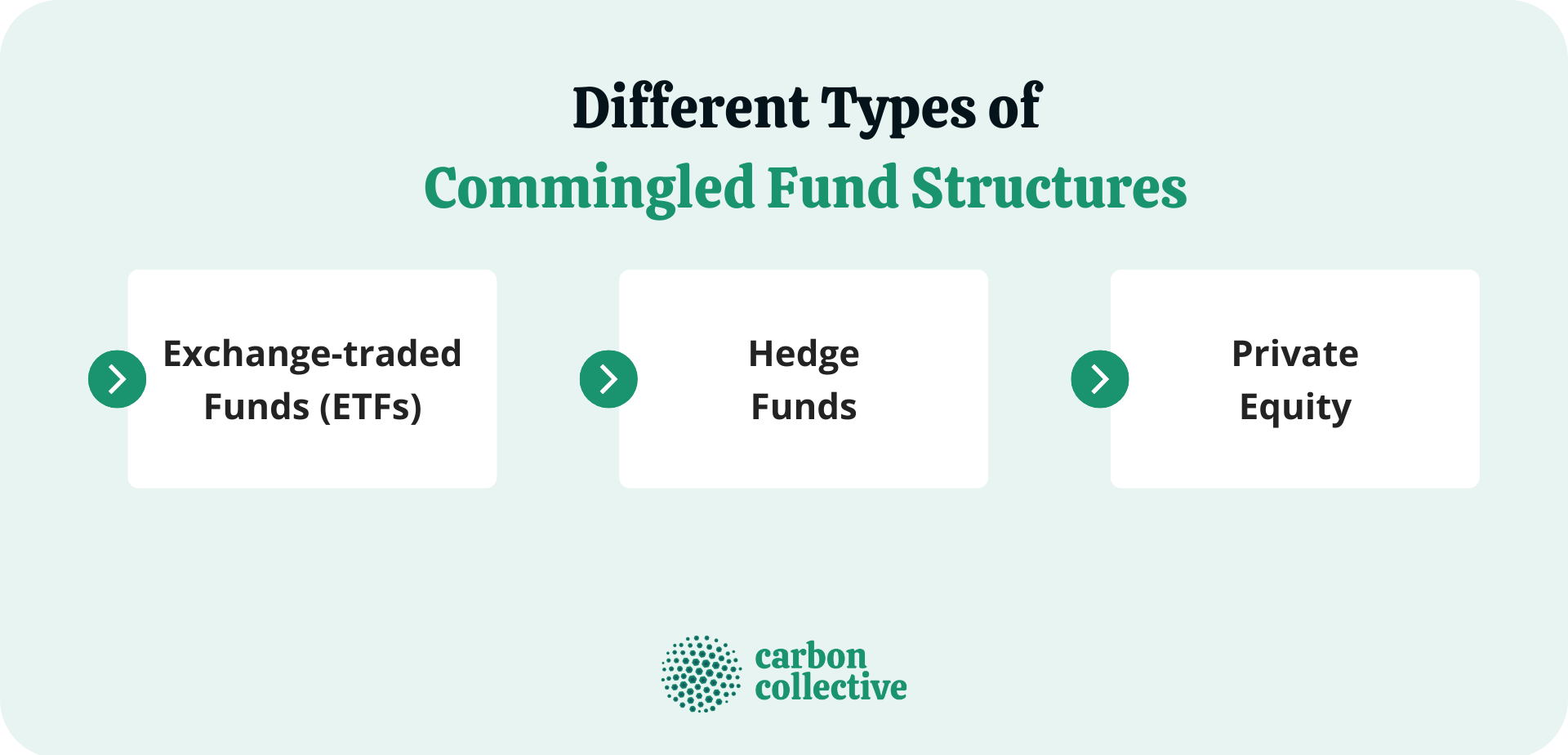What Is a Commingled Fund?
When it comes to commingled funds, there are several options and terms you need to familiarize yourself with to make the best investment decisions.
In short, a commingled fund is an investment vehicle where money from different investors is commingled or mixed for various reasons, but most often to pool resources and reduce costs.
When you invest in a commingled fund, you essentially pool your money with other investors and entrust the fund manager to make investment decisions on your behalf.
Different Types of Commingled Fund Structures
There are several types of commingled fund structures. Here are some of the most common:

- Exchange-traded funds (ETFs): An ETF is a commingled fund traded on an exchange, like a stock. ETFs often track an index, such as the S&P 500, or a sector, such as healthcare
- Hedge funds: A hedge fund is a commingled fund that uses aggressive strategies to generate higher returns. Hedge funds are typically only available to accredited investors
- Private equity: Private equity is a commingled fund that invests in non-publicly traded companies
Commingled Funds vs Mutual Funds
A mutual fund is a type of fund that pools money from different investors and invests it in a variety of securities, such as stocks, bonds, and other assets.
The biggest difference between commingled funds and mutual funds is that commingled fund investments are not regulated by the same laws as mutual funds.
This means commingled fund managers have more flexibility when investing, but it also means more risk.
Another difference is that commingled funds are not required to disclose their holdings or provide regular reports to investors, unlike mutual funds.
This lack of transparency can be a downside for some investors, but it also allows commingled fund managers to take advantage of opportunities potentially unavailable to mutual fund managers.
Commingled Fund Advantages
There are several advantages to investing in commingled funds.
First, commingled funds offer the potential for higher returns than traditional investments, such as mutual funds.
This is because commingled fund managers have more flexibility when investing and are not bound by the same regulations as mutual fund managers.
Second, commingled funds can be a good way to diversify your portfolio.
By investing in a commingled fund, you essentially invest in a large pool of securities, which can help reduce risk.
And third, commingled funds offer the potential for tax-advantaged growth.
This is because commingled fund managers can take advantage of opportunities to defer or minimize taxes on your behalf.
Commingled Fund Disadvantages
There are also some disadvantages to investing in commingled funds.
First, commingled funds can be more expensive than traditional investments, such as mutual funds.
This is because commingled fund managers typically charge higher fees for their services.
Second, commingled funds can be illiquid, making it tricky to sell your investment if you need to access your money.
And third, commingled funds can be risky.
This is because the lack of regulation means that commingled fund managers have more freedom to make risky investment decisions.
Should You Invest in Commingled Funds?
Investing in commingled funds should align with your financial goals and risk tolerance.
If you are looking for higher returns, commingled funds may represent a good option for you. But if you are risk-averse, commingled funds may not suit you.
And if you want a way to diversify your portfolio, commingled funds can be a good option. But if you are looking for a safe and regulated investment, commingled funds may not be right for you.
Ultimately, the decision of whether or not to invest in commingled funds is a personal one.
If you have any questions about commingled funds, speak with a financial advisor.
The Bottom Line
Commingled funds are a type of investment vehicle that pools together the assets of many different investors.
Commingled funds offer the potential for higher returns and more flexibility when investing, but they also come with more risk.
Whether or not commingled funds suit you depends on your financial goals and risk tolerance.
If you have any questions about commingled funds, speak with a financial advisor.
FAQs
1. What if I need to access my money?
If you need to access your money, commingled funds can be illiquid, meaning you might encounter difficulties selling your investment. It is important to keep this in mind if considering investing in commingled funds.
2. Can commingled fund managers make risky investment decisions?
Yes, commingled fund managers can make risky investment decisions because they are not bound by the same regulations as mutual fund managers. Although this lack of regulation can be a downside for some investors, it allows commingled fund managers to take advantage of opportunities that may not be available to mutual fund managers.
3. How much do commingled fund managers charge in fees?
Commingled fund managers typically charge higher fees for their services than traditional investment managers, such as mutual fund managers. This is because commingled funds can be more complex and time-consuming to manage.
4. Can I transfer my commingled funds to mutual funds?
Yes, you can transfer your commingled funds to mutual funds. However, you may not be able to do so without incurring taxes or penalties.
5. Are commingled funds tax-advantaged?
Yes, commingled funds can offer the potential for tax-advantaged growth. This is because commingled fund managers can take advantage of opportunities to defer or minimize taxes on your behalf. However, commingled funds are not necessarily tax-free because they are subject to the same taxes as other investment vehicles.
